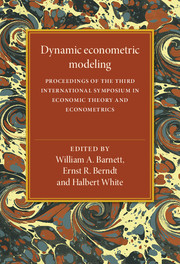 Dynamic Econometric Modeling
Dynamic Econometric Modeling Published online by Cambridge University Press: 03 May 2010
Time series analysts (often “econometricians”) working in institutions involved with economic policy making or short–term economic analysis face two important professional demands: forecasting and unobserved components estimation (including seasonal adjustment). Estimation of unobserved components is overwhelmingly done in practice by using ad hoc filters; the most popular example is estimation of the seasonally adjusted series with the Xll or Xll ARIMA program.
Concerning forecasting, the decade of the seventies witnessed the proliferation of autoregressive integrated moving–average (ARIMA) models (Box and Jenkins 1970), which seemed to capture well the evolution of many series. Since this evolution is related to the presence of trend, seasonal, and noise variation, the possibility of using ARIMA models in the context of unobserved components was soon recognized. Since the early work of Grether and Nerlove (1970) on stationary series, several approaches have been suggested. I shall concentrate on one that is becoming, in my opinion, a powerful statistical tool in applied time series work [starting references are Cleveland and Tiao (1976) and Box, Hillmer, and Tiao (1978); more recent references are Bell and Hillmer (1984) and Maravall and Pierce (1987)]. In the context of an application related to the control of the Spanish money supply, I shall address the issues of model specification, estimation of the components, diagnostic checking of the results, and inference drawing.
To save this book to your Kindle, first ensure [email protected] is added to your Approved Personal Document E-mail List under your Personal Document Settings on the Manage Your Content and Devices page of your Amazon account. Then enter the ‘name’ part of your Kindle email address below. Find out more about saving to your Kindle.
Note you can select to save to either the @free.kindle.com or @kindle.com variations. ‘@free.kindle.com’ emails are free but can only be saved to your device when it is connected to wi-fi. ‘@kindle.com’ emails can be delivered even when you are not connected to wi-fi, but note that service fees apply.
Find out more about the Kindle Personal Document Service.
To save content items to your account, please confirm that you agree to abide by our usage policies. If this is the first time you use this feature, you will be asked to authorise Cambridge Core to connect with your account. Find out more about saving content to Dropbox.
To save content items to your account, please confirm that you agree to abide by our usage policies. If this is the first time you use this feature, you will be asked to authorise Cambridge Core to connect with your account. Find out more about saving content to Google Drive.